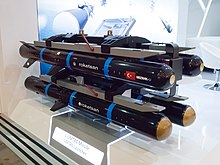avia.wikisort.org - Weapon
UMTAS or Mizrak-U (Uzun Menzilli Tanksavar Sistemi) is a modern long range air-to-surface anti-tank missile developed by Turkish armor and missile manufacturer ROKETSAN.[3][4][5][6][7]
| UMTAS Long Range Anti-Tank Missile System | |
|---|---|
 L-UMTAS (upper) and UMTAS (lower) missiles displayed on helicopter pylon | |
| Type | Air-to-surface, Anti-tank missile |
| Place of origin | Turkey |
| Production history | |
| Manufacturer | ROKETSAN |
| Specifications | |
| Mass | 37.5 kg[1] |
| Length | 175 cm |
| Diameter | 16 cm |
| Warhead | Insensitive Anti-armor Tandem Warhead |
| Engine | Solid-fuel rocket |
Operational range | 500–8,000 m |
Guidance system | Two-way RF data-link Imaging Infrared Seeker (UMTAS) or semi-active laser guidance (L-UMTAS) |
Launch platform | Attack helicopter[2] Unmanned air vehicle[2] TAI Hürkuş[2] Ground vehicle Naval platforms |
| External image | |
|---|---|
| Launch and Warhead test | |
Background

The UMTAS program was initiated in late 2003 by Turkey's Undersecretariat for Defence Industries (SSM), specifically to provide T-129 ATAK combat helicopters with an indigenous guided missile.[8] The UMTAS has been designed to engage tanks and heavily armoured vehicles.[9] It can be integrated to various platforms (Helicopters, UAVs, Land Vehicles, Stationary Platforms, Light Assault Aircraft, Naval Platforms).[4]
Description
The UMTAS missile features "fire and forget" and "fire and update" infrared guidance with a tandem anti-armor warhead.[3] The laser guided version is marketed as the L-UMTAS.[4] İsmail Demir, the Head of Defence Industry of Turkiye stated that it's capable of engaging targets at 16 kilometers.
- Fire Behind Mask
- Can be used in day or night and in adverse weather conditions
- Tandem-charge warhead, effective against reactive armour
- Insensitive munition characteristics against liquid fuel fire and bullet hits
- Communication of seeker image to the user and command by user using data-link
- Lock-on before launch or lock-on after launch (L-UMTAS)
- Update of aim point on the target (UMTAS)
- Switching targets during flight (UMTAS)
- Direct-attack / Top-attack (UMTAS)
- Fire-and-Forget, Fire-and-Update modes (UMTAS)
Development
Phase 1 (design) was launched in 2005 and completed in 2008.[1]
Phase 2 (development and qualification) was launched in 2008 and completed in 2015.[9]
The L-UMTAS and UMTAS version have been successfully integrated and fired from the Turkish T-129 ATAK helicopter against land targets and from SH-60 Sea Hawks against sea targets.
The missile has also been successfully tested fired from the Bayraktar TB2 UCAV. The missile was dropped from an altitude of 16,000 ft to hit a 2×2 meter laser-designated target self designated from the drone, at a distance of 8,000 meters.[10] The MAM-L smart munition was developed from L-UMTAS.[11]
Serial production has begun with the delivery dates set in 2016.[9]
References
- LONG RANGE ANTITANK MISSILE (LRAT) Archived 2011-06-16 at the Wayback Machine, Roketsan, Retrieved October 11, 2010
- Mitzer, Stijn (13 January 2022). "Deadly Advanced: A Complete Overview Of Turkish Designed Air-Launched Munitions". Oryx Blog.
- "UMTAS LONG RANGE ANTI-TANK MISSILE SYSTEM « Roketsan". www.roketsan.com.tr. Archived from the original on 5 February 2021. Retrieved 13 July 2021.
- "Long Range Anti-Tank Missile UMTAS « Roketsan". www.roketsan.com.tr. Archived from the original on 4 March 2021. Retrieved 12 July 2021.
- "UMTAS Long Range Anti-Tank Missile System - Army Technology". Archived from the original on 2019-03-24.
- UMTAS (Long Range Anti Tank System) (Turkey) Archived 2010-04-28 at the Wayback Machine, Jane's Information Group, Retrieved October 10, 2010
- "UMTAS Long Range Anti-Tank Missile System « Roketsan". Archived from the original on 2019-04-14. Retrieved 2019-07-22.
- "SAVUNMA SANAYİİ MÜSTEŞARLIĞI Faaliyet Raporu 2013" (pdf). Kamuda Stratejik Yönetim. 2013. p. 99. Retrieved 24 April 2021.
{{cite web}}: CS1 maint: url-status (link) - "Roketsan Shows Broad Capabilities". aviationweek.com. Archived from the original on 2016-06-02. Retrieved 2016-04-28.
- Eshel, Tamir (19 December 2015). "Turkish UMTAS Missile Dropped From a Bayraktar Tactical Drone | Defense Update". defense-update.com. Archived from the original on 2016-04-13. Retrieved 2016-04-28.
- "MAM-L Smart Micro Munition | Turkish Defence News". Retrieved 2022-04-18.
На других языках
- [en] UMTAS
[ru] UMTAS
UMTAS (тур. Uzun Menzilli Tanksavar Sistemi — рус. Противотанковый Ракетный Комплекс Большой Дальности) — турецкий противотанковый ракетный комплекс. Разрабатывался фирмой Рокетсан (Турция) с 2005 года, также принимали участие фирмы Аселсан (электронное оборудование) и МКЕК (БЧ). Стоимость разработок составила не менее 38 млн долларов.Другой контент может иметь иную лицензию. Перед использованием материалов сайта WikiSort.org внимательно изучите правила лицензирования конкретных элементов наполнения сайта.
WikiSort.org - проект по пересортировке и дополнению контента Википедии